Client
First, the market review
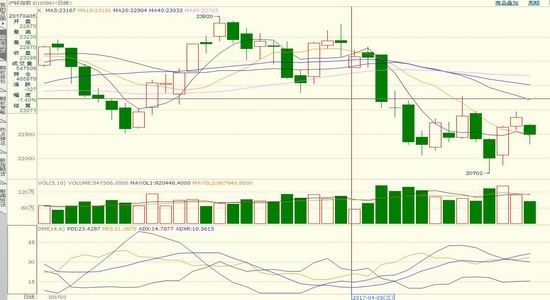
In April 2017, the Shanghai Zinc Index showed a general downward trend, closing the Yinxian line and increasing the trading volume. First of all, from April 5, the gap opened lower at 22,870 points, the day opened for the lowest price, it seems that the trend is strong, but the good times did not last April 7 at the highest price to open and close the big Yinxian, the day fell 890 points The biggest single day of the month, this decline will break the technical support, making the bulls lose confidence. Since then, the trend has been dominated by the yin, and occasionally the rebound has also shown insufficient strength. It was the lowest of 20,702 points in the month until April 19, and then it fluctuated and rebounded from the end of the month, but the strength was not strong. In April, the price volatility was huge. It was the biggest decline in the year. The maximum volatility was 2,592 points, down 1882 points. In April, it was a unilateral decline, and the rate of correction was small. The operation is mainly based on long-term light warehouse empty orders.
Second, the macro side
1. China PMI
In March 2017, the China Manufacturing Purchasing Managers Index (PMI) was 51.8%, rising for two consecutive months, up from 0.2 percentage points last month. The manufacturing industry continued to maintain a stable and good trend.
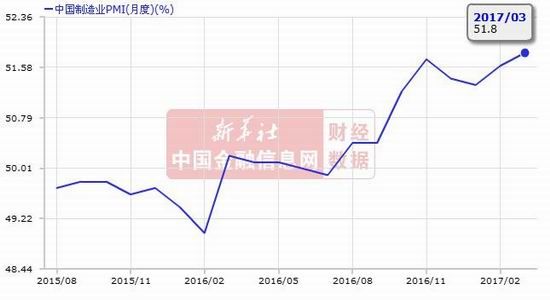
In terms of the size of the enterprise, the PMI of large enterprises was 53.3%, which was the same as that of the previous month and continued to maintain a stable expansion. The medium-sized enterprise PMI was 50.4%, which was 0.1 percentage points lower than the previous month, and continued to expand; the small enterprise PMI was 48.6%. The monthly increase was 2.2 percentage points, and the contraction rate narrowed significantly.
The raw material inventory index was 48.3%, down 0.3 percentage points from the previous month and continued to fall below the critical point, indicating that the main raw material inventory of the manufacturing industry continued to decline.
The supplier's delivery time index was 50.3%, although it was 0.2 percentage points lower than the previous month, but it was still above the critical point, indicating that the delivery time of manufacturing raw material suppliers was slightly accelerated.
2. Euro zone PMI
According to data released by Markit (April 21), the Eurozone economy continued to grow strongly in the second quarter. The PMI data in April continued to be the highest in six years; France's corporate activities in April were particularly bright, and the elections did not cool the economy; However, the growth rate of the German private sector slowed in April, as the growth of the service industry slowed down.
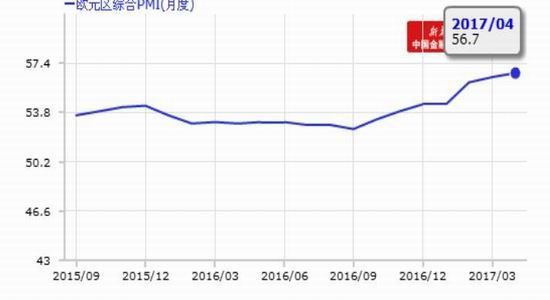
According to data released by Markit on the same day, the Eurozone economy continued to grow strongly in the second quarter, new orders remained strong, and the pace of corporate activity expansion was the fastest in six years.
The initial value of the Markit manufacturing PMI in the Eurozone in April was 56.8, higher than the expected value of 56 and the previous value of 56.2; the initial value of the Markit comprehensive PMI in the Eurozone in April was 56.7, the highest since April 2011, higher than the expected value and the previous value. (both are 56.4).
The data also showed that the employment sub-index was steady at 54.4, the highest since November 2007. The index measuring manufacturing output rose from 57.5 in the previous month to a maximum of 58.0 since April 2011.
3, the United States PMI
According to a report released by the American Institute of Supply Management, due to the slowdown in orders and production growth, the US manufacturing expansion rate in March this year has dropped from the previous month's high.
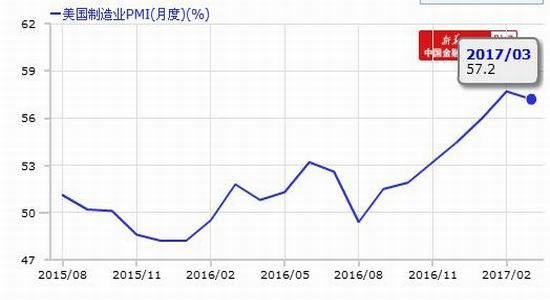
The report showed that the US manufacturing purchasing managers' index fell slightly to 57.2 in March from 57.7 in the previous month. The manufacturing new orders index fell slightly by 0.6 points to 64.5; the production index fell by 5.3 points to 57.6; while the employment index rose by 4.7 points to 58.9. In terms of industries, 17 of the 18 industries surveyed achieved expansion. The survey shows that the industry surveyed is generally optimistic about the business situation and prospects, and believes that corporate sales will maintain steady growth.
Third, the fundamental analysis 1, zinc supply status
(1) London, April 12, the data released by the International Lead and Zinc Research Group (ILZSG) showed that the global zinc market had a surplus of 19,800 tons in February and a shortfall of 22,300 tons in January.
In January-February, the global zinc market was short of 2,000 tons, compared with a surplus of 44,000 tons in the same period last year. According to ILZSG, zinc stocks in consumers, producers and exchanges fell to 1,395,800 tons in February, compared with 1,371,000 tons in January.
The following is the detailed data: (Unit: thousand tons)
(2) London April 19 news, the World Bureau of Metal Statistics (WBMS) official website released data show that in January-February 2017, the global zinc market supply shortage of 177,000 tons, 2016 full supply shortage of 258,000 tons.
In February, LME zinc stocks decreased by 12,000 tons, and inventories at the end of February were 44,000 tons lower than the end of 2016. LME zinc stocks account for 37% of global inventories. China's zinc demand increased by 2.7% compared with the same period last year.
In the January-February 2017, global refined zinc production increased by 6.0% year-on-year, and consumption increased by 7% compared with the same period of last year. Demand in Japan was 87,000 tons, an increase of 16% over the same period in 2016.
Global demand for refined zinc in January-February 2017 increased by 143,000 tons compared to the same period in 2016.
The apparent demand for zinc in China is 967,000 tons, accounting for 44% of the total global demand.
In February 2017, the global production of flat zinc ingots was 1,134,700 tons, and the consumption was 1,083,900 tons.
(3) Operating rate of major domestic zinc smelting enterprises
The average operating rate of zinc smelting in March was 69.4%, a decrease of 0.4% from the previous month and a decrease of 5.96% from the same period last year. In the first quarter of 2017, the average operating rate of zinc smelting enterprises was 70.67%, which was 0.99 percentage points lower than the same period of 2016, down 1.38% year-on-year. The operating rate in April is expected to be 66.5%, which is still lower than that in March.
Zinc smelting enterprises operating rate
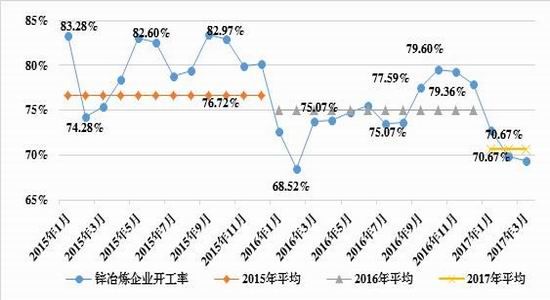
The reason why the operating rate of zinc smelting enterprises continued to decline since 2017 is mainly
1. Since the second half of 2016, the supply of zinc concentrate has continued to tighten. The international and domestic zinc concentrate processing fees have been falling all the time. The cost of raw materials for smelters has increased substantially, profits have been squeezed by mines, and the enthusiasm of some smelters with poor capital conditions has been suppressed.
2. At the end of the Spring Festival, the smelter was affected by the seasonal high electricity price pressure and entered the regular maintenance period. In March, the smelting plant in Guangxi, Guangxi, successively overhauled and reduced production. At the same time, the smelting plant reached a joint production reduction agreement to promote the processing of zinc concentrate processing fees. In March, 12 domestic zinc smelting backbone enterprise seminars were held in Xi'an, and 9 of them have taken measures to stop production and maintenance in March or soon, zinc smelting enterprises. The operating rate has fallen sharply.
3. At the end of the Spring Festival, zinc gradually entered the peak season of consumption. However, affected by the two sessions and the new round of environmental supervision in 2017, the operating rate of galvanizing enterprises in North China and die-casting enterprises in South China fell sharply compared with previous years. The downstream demand for zinc recovered from previous years. Significantly postponed. In addition, since 2017, China has increased its real estate regulation, mortgage interest rates have risen, and property consumption expectations have been greatly reduced. Affected by the downstream demand, the zinc smelting enterprises started to decline.
2. Downstream consumption
(1) The survey shows that the operating rate of galvanized enterprises in March was 80.38%, up 14.45% from the previous month, mainly due to the resumption of work after the holiday; the operating rate dropped 11.83% year-on-year. The main reason was that the galvanizing enterprises in North China were suspended due to environmental impact in March. , the overall operating rate has been dragged down. The galvanized sector is still affected by environmental factors. It is also understood that the demand for galvanized terminals is less than that of the same period last year. It is expected that the operating rate will fall back to 74.5% in April.
(2) In March 2017, the operating rate of zinc oxide enterprises was 58.4%, an increase of 2.6 percentage points. Since the “two sessions†held in mid-March, environmental inspections have become stricter, and some of the zinc oxide enterprises in Hebei have been restricted in production, resulting in a significant increase in the operating rate of zinc oxide in March, which will drag down the April production. According to the enterprise scheduling plan, the operating rate of zinc oxide is expected to fall slightly to around 57% in April.
(3) The operating rate of die-cast zinc alloy enterprises in March was 58.8%%, up 15.4% from 2 months. According to the enterprise's billing plan, the operating rate of die-cast zinc alloy in April was 60.4%, a slight increase of 1.58% compared with March. Consumption continues to improve, mainly in the zipper pull, door and window locks, electronic appliances and other products orders.
V. Summary and outlook
From a macro perspective, the Chinese economy has steadily increased and maintained a moderate expansion. The economic trend in the euro zone is in a positive direction. The US economy began to grow, and the survey showed that the US economy was improving in the second quarter. Overall, the macro economy has shown signs of gradual improvement and the global economy is picking up.
Fundamentally, the early zinc mines were tightly transferred to the smelter to reduce production and maintenance. The supply side is limited. It is difficult to increase the output and import volume in April. However, the demand for galvanizing has been greatly weakened. The rest of the market is not bright, and the overall supply and demand are weak. In the current overall industry chain inventory continues to decline, due to the low zinc prices in the early period, smelter profits fell rapidly, maintenance and production increased, there is limited room for further decline here, it is recommended to be cautious, while paying attention to the negative impact of weak demand .
Overall, as the global macro economy gradually recovers, while supply is still tight, and weak demand affects the increase, as the traditional consumption season in the first half of the year draws to a close, demand pressure will become more and more obvious, and May 2017 may be cautiously bullish. Do not chase high.
Da Yue Futures
Sina statement: Sina's posting of this article for the purpose of transmitting more information does not mean agreeing with its views or confirming its description. Article content is for reference only and does not constitute investment advice. Investors operate on this basis at their own risk.Antimony Ingot,Antimony Lead Ingots,Antimony Metal Ingots,Bismuth Metal Ingot
HUNAN ZHONGNAN ANTIMONY&TUNGSTEN TRADING CO.,LTD , https://www.znat.com.cn